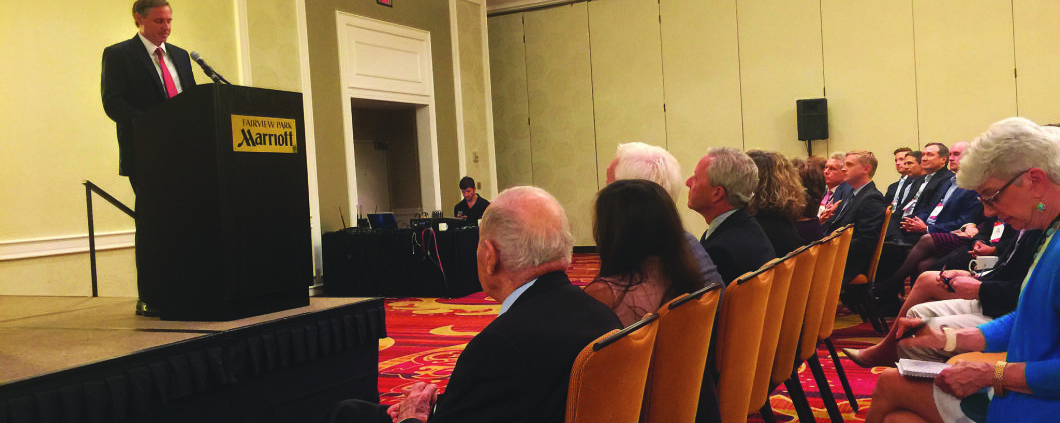Mayor Tarter champions the City to regional developers
The City of Falls Church was held up as an example of the kind of “more authentic experience” of living that developers in Fairfax County should strive to emulate during a high-powered forum on prospects for the regional economy yesterday.
Falls Church represents “a little bit more of an authentic experience” said real estate developer Albert “Sonny” Small Jr. of Renaissance Centro amid an energetic four-way discussion on how to best develop in Fairfax County in order to attract a younger tech-savvy “Millennial” demographic sorely needed to fuel the area’s economy.
Greg Trimmer of the JBG companies who shared the panel with Small, Peter Otteni of Boston Properties and Tony Womack of Tishman Speyer, cited Falls Church’s emphasis on marrying development with quality education as representing the kind of “amenities” that will attract Millennials.
It helped that the panel was preceded by Falls Church Mayor David Tarter, who delivered a brief but powerful and comprehensive overview of the City of Falls Church.
Tarter cited the City’s demographics (highest per household income and level of educated population of any jurisdiction in the U.S.), its central location between two Metro stations seven miles from the White House, its “great schools,” and “small town feel” (its farmer’s market, State Theatre, Eden Center), second fastest growing population in Virginia, bike share and pedestrian-friendly initiatives, and its planned W&OD Trail, City Hall, high school and library and other public investments in infrastructure.
He noted the City’s effort to articulate the commercial potential of eight nodes in the City, the recent opening of a flagship Harris Teeter and Hilton Garden Inn in the center of its downtown, and approvals for a movie theater and hotel, and its demonstrated capacity for innovation and agility, demonstrated by the deal to land the BJ’s Wholesale Warehouse instead of a car lot, tech zone and tax incentives. He culminated his talk by citing the 10 undeveloped acres at the West Falls Church Metro station, having been “decoupled” from the construction or renovation of a new high school, being “perhaps the largest vacant site near a Metro in the region.”
The four panelists incorporated those remarks with those earlier by Jerry Gordon of the Fairfax County Economic Development Authority, who said that despite the gloomy projections four years ago of a decline in federal contracts (which was true), growth in the county has remained very robust, and has created a “desperate need” to augment “a workforce of qualified, sorely needed tech workers.”
He said Fairfax County has built up 116 million square feet of office space, making it the second largest suburban office space center in the U.S. (second only to Orange County, California). While the attention has been on the 20 million square feet of vacant space, he said, that can miss the fact that 96 million square feet is filled, more than in all the rest of Northern Virginia combined and constituting 32 percent of all the office space in Virginia.
“We’ve still got a very long way to go yet” to fill up the 20 million square feet of vacant space, he said, and that set the framework for the panel discussion on how to achieve just that.
A lot of the talk centered on “amenitizing” spaces, filling in office spaces and residential areas with amenities that will attract new qualified workers and their families.
“There needs to be value planning,” said Womack, and ideas included providing conference room spaces for the growing numbers of “free lancers” working from their homes.
The need for a major research university was also cited, and bringing in major retailers like Wegman’s to Tysons was also mentioned as key to luring qualified Millennials away from Arlington’s Rosslyn-Ballston corridor, for example.
In 20 years, Tysons and Reston will both “be cities,” Trimmer said, but the challenge will be realizing that potential in the best way. Transportation limitations won’t be too great an impediment, such as the track work on the Metro system, increased costs of its expansion and tolls on I-66. “There are a lot more factors involved that go into where a family may choose to live,” said Otteni, noting that such transportation problems are more likely to impact Loudoun County further to the west.
People are willing to pay for convenience, Small said.
The panelists took friendly positions on whether Tysons or Reston will evolve into the county’s main downtown, but Small favored Tysons because “it is closer to Falls Church, which offers a little bit more of an authentic experience.”
“How do you create that authenticity?” he asked, citing how downtown Washington, D.C. is also developing that. “Right now,” he said, “That’s not the vibe in Fairfax County.”
Yesterday’s conference, organized by Biznow in conjunction with the Fairfax County Economic Development Authority, was entitled, “Fairfax County State of the Market: Big Developments in Northern Virginia’s Largest County,” and was attended by an estimated 300 commercial real estate professionals at the Fairview Marriott.




